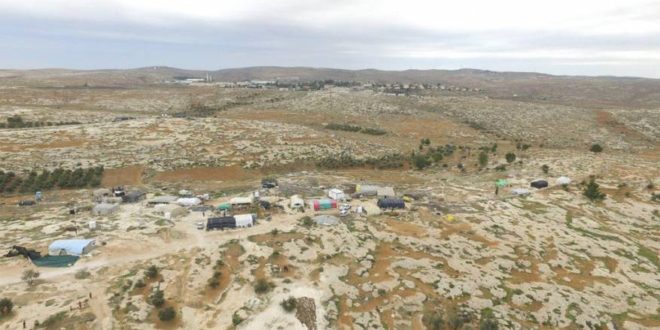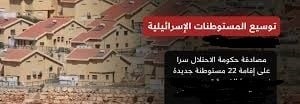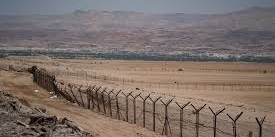BY:Madeeha Araj
The National Bureau for defending land and resisting settlements ( nbprs ) stated in its latest weekly report , that the agreements that were signed between the centrist parties and the right-wing Zionist parties in the Bennett’s government, such as, the Yesh Atid, Yemina and Tikva Hadasha parties, clearly stipulated to form a ‘monitoring body’ to retain Area C in the occupied West Bank, besides, strengthening and expanding what they named ‘heritage sites’, and approving the building of 300,000 housing units at affordable prices in the West Bank, including Jerusalem, which mean that the new gov’t follows the same policy of the previous Israeli governments in destroying house, stealing Palestinian lands, and construct settlements, as well as strengthening and expanding construction in the city, and transfer it as a center for all ministries, departments and Israeli government institutions.
Multiple sources report that the new Israeli government will intensify monitoring of Palestinian construction activities in Area C, as Defense Minister Benny Gantz, and Gideon Sa’ar, leader of the Tikvah Hadshah party, who holds the position of Minister of Justice in the new government, reached an agreement to appoint 50 inspectors to monitor the Palestinian construction, while their work won’t include settlers construction in these areas. Knowing that the Inspection Department at the Civil Administration has until now monitored Jewish and Palestinian construction activities in Area C, it rarely demolishes what settlers build, but always demolishes what Palestinians build. Israeli journalist Barak Rafid, a political commentator for the Wallallah website, said in a tweet that the decision that the new government will implement in the West Bank constitutes clear evidence of imposing of the ‘apartheid regime’, warning that large circles in the American Democratic Party won’t agree with that.
On the other hand, the Israeli occupation municipality in occupied Jerusalem, supported by the ‘Israeli Ministry of Religions’ intends to build a new huge bridge in the Moroccan Gate, and remove the wooden bridge designated for the incursions of extremist settlers. It is 2/5 m wide, and 70 m long, although previous excavations were carried out in this area that led to cracks and collapses in the wall. Certainly, these excavations will inevitably lead to significant damage to the Al-Aqsa Mosque and its gates.
In Silwan, the Israeli Occupation Authorities renewed demolition notices for 13 Palestinian families in the Al-Bustan Neighborhood in Silwan, south of the occupied Jerusalem of about 100 families whose homes have been threatened with demolition for several years. The head of the Silwan Land Defense Committee, Fakhri Abu Diab, said that teams from the occupation municipality in Jerusalem delivered reports of demolishing homes belonging to 13 Jerusalemite families living in the Al-Bustan neighborhood within 21 days. According to Abu Diab, the area of Silwan’s lands is 5,640 dunums, and it includes 12 neighborhoods, inhabited by about 58,500 Jerusalemites, and there are 78 outposts in which 2,800 settlers live.
The policy of displacement and ethnic cleansing is not limited to Jerusalem and its neighborhoods, but includes a number of areas in the West Bank, such as the Jordan Valley and areas south of Hebron. The occupation army demolished a Palestinian residential community north of Jericho, leaving its residents in the open air without shelter. The demolition included 4 houses and 6 barracks ‘tin and iron structures’ used to house livestock in the Arab al-Ka’bneh area in al-Ma’rjat area under the pretext of not having licenses. The occupation forces had come a few days ago and filmed the gathering, and later they came and dismantled and confiscated all the facilities. The Palestinian community is located in an area “C” under full Israeli control, and construction or land reclamation in these areas is prohibited without permits from the occupying authorities, which are almost impossible to obtain.
List of Israeli Assaults over the Last Week Documented by the National Bureau:
Jerusalem:
- Opening a settlement road near the main entrance to the Hizma town, northeast of Jerusalem, extending from the town’s entrance to the Sha’b area near the main Hizma Jaba Street. It is noteworthy that the Hizma town is surrounded by 4 settlements and is considered the main junction that links the north and south of the West Bank and one of the main gates of the city of Jerusalem.
- Putting up a sign by the so-called ;Women for the Temple; organization at the entrance to the Moroccan Gate reading ‘Halil Gate’ in an attempt to change the name of the gate after the name of the Israeli Hillel Ariel, who was killed in the Kiryat Arba settlement in Hebron in 2016.
- Approving the holding of the flags march in occupied Jerusalem after the formation of the new government, provided that its date will be coordinated later.
Hebron:
- Bulldozing 2 agricultural streets in Masafer Yatta, south of Hebron that were built in 2019 and link between Yatta and Khallet al-Daba in Masafer Yatta. Shaab al-Butm Street was also bulldozed in order to prevent citizens from communicating between the villages of Yatta areas and its travelers in preparation for its confiscation.
- Demolishing a sheep-tent belonging to Mohamad Issa Rabai in the village of Al-Tawana, and an agricultural room south of Hebron belonging to Fadel Raba’a in the Al-Rakeez community, east of Yatta.
- Preventing the Hebron Reconstruction Committee from working in one of the houses located in the Al-Sahla area in the Old City of Hebron, and forcing it to remove construction materials.
Nablus:
- Invading the eastern area of Nablus in preparation for the settlers’ buses to enter Qabr Yousif – “Joseph’s Tomb” under the pretext of holding Talmudic prayers there.
- Attacking vehicles with stones on the road between Nablus and Qalqilya, injuring the passengers.
- Storming the Sabastia town, northwest of Nablus, closing the archaeological area west of the town, as soldiers roamed the area holding its map.
Salfeet:
- Uprooting 180 olive trees, aged between 5-10 years in the area of Dahr Sobh north of the Kafr Ad-Dik town, west of Salfit under the pretext that it is area C, and demolished a rainwater-well, and demolished stone-walls built on an area of 500 m.
Jenin:
- Immediate demolition orders for commercial stores under the pretext of being built without a permit in Um al-Rihan village, with the aim of establishing a new settlement, and preventing the town from expansion.
Jordan Valley:
- Demolishing 2 agricultural pools in the Bardala village in the northern Jordan Valley serving a number of farmers, provided by the Ministry of Agriculture. It also bulldozed an agricultural road in the Qa’oon plain, west of the village with a 1600m length that serves farmers there.
- Establishing a settlement room near Ein Hilweh in the northern Palestinian Jordan Valley, and began rehabilitating a settlement road linking the area.
 المكتب الوطني للدفاع عن الارض ومقاومة الاستيطان منظمة التحرير الفلسطينية
المكتب الوطني للدفاع عن الارض ومقاومة الاستيطان منظمة التحرير الفلسطينية




